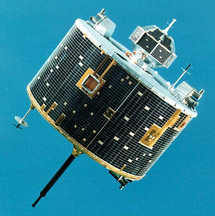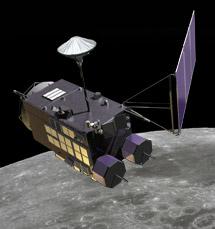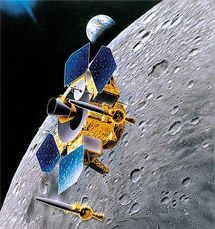

Q. What is the history of Japanese lunar exploration?
The first Japanese explorer to the Moon was Hiten (Muses-A), launched in 1990. The purpose of that mission was to learn how to navigate to the Moon and to master the so-called energy-saving technique of the gravitational slingshot, which is indispensable for future lunar and planetary exploration. Hiten released a tiny satellite, Hagoromo, into lunar orbit, but Hagoromo unfortunately ended up having a very short life span. After orbiting the Earth and Moon many times, Hiten ended its mission by impacting on the Moon in April 1993. Hiten is Japan's only lunar probe so far, though its objective was not lunar exploration, but rather studying navigational technology for orbital control, in order to learn how to send a probe into Moon orbit. The knowledge gained from that mission has been applied not only to Japan's later planetary spacecraft, but also to improving technology for other explorers from around the world. In addition, many countries have adopted the slingshot technique, which allows us to use a small amount of fuel to reach other planets.

Japanese Moon Explorer Hiten, launched in 1990

Japanese Moon Explorer SELENE

Japanese Moon Explorer LUNAR-A. The mission is being considered for cancellation.
A joint experiment with Technische Universität München of Germany, called the Munich Dust Counter (MDC), was also on board Hiten. This instrument measured cosmic dust orbiting in space between the Earth and the Moon, and I was in charge of Japanese team. This experiment was very exciting. Among the dust particles that impacted onto the counter, we found some that were traveling at almost 100 km per second, which led us to conclude that they must have come from outside the solar system. It was a significant discovery that near the Earth there was matter that had traveled such a long distance. To me, Hiten is definitely one of the most memorable spacecraft.
Q. What do you think about the lunar exploration missions Japan currently has in preparation?
The lunar orbiter SELENE is scheduled to be launched this summer. I think it's quite an advanced remote-sensing spacecraft, even by international standards. This is a much more comprehensive lunar mission than Clementine, the Lunar Prospector, or SMART-1, and I think SELENE will produce the most remarkable results since the Apollo missions. The lunar explorer will be equipped with 15 scientific instruments, including an altimeter to map the topography of the Moon, a stereo camera for three-dimensional images, a magnetometer to study the lunar magnetic fields, various spectrometers to investigate the mineral and elemental compositions of lunar rocks and minerals. In addition, it has two sub-satellites which will be used to study the gravitational field of the Moon. It may sound overstuffed, but we won't be able to learn about the true nature of Moon otherwise.
Many people may think that the Apollo missions revealed almost everything and that there is not much left to study about the Moon. On the contrary, we know very little about it even now. What we do know about the Moon is primarily based on measurements with spatial resolution of more than a kilometer. On the 10-meter scale, we might find a completely different world. You cannot identify an object in an out-of-focus image, so without sharply focused images and data on chemical and mineral compositions, it is difficult to solve the mysteries of the Moon.
There is also the other mission, LUNAR-A, which is designed to study the Moon's internal structure by seismic observation with novel devices called penetrators. LUNAR-A has a very different observation methodology than SELENE but shares the same goal: to discover how the Moon was born and how it has evolved over 4.5 billion years. The success of LUNAR-A will eventually lead to exploration using a lunar surface network to survey the Moon's interior structure. For network exploration, we will have to deploy an observation system similar to Earth's seismometer network on the Moon's entire surface. Even though the penetrator technology has now reached a satisfactory level, a proposal for an indefinite postponement of the mission has been submitted to the Space Activity Commission, because there is concern about the possible deterioration of the mother ship due to prolonged storage. I hope someday the penetrator technology will have a chance to see the light of day. I look forward to it.
Q. What do you look forward to most from SELENE's observations?
I'm interested in everything which will be brought by SELENE. SELENE's incomparably high-quality images will reveal the topography of the Moon. I think that its three-dimensional images will be very interesting for the public, too.
I'm personally very interested in lunar magnetic field observation. It is believed that there are no magnetic fields on the Moon, but interestingly there are magnetized areas on the moon. This is called magnetic anomaly, and we still don't really know what it is. By studying the lunar magnetic anomaly in detail, we might be able to make a great discovery on whether there used to be lunar magnetic fields in the past, sometime between its birth and some billion years later. If we can verify the existence of past lunar magnetic fields, perhaps we will also find a more satisfactory explanation for the geodynamic processes of planets.
If there were magnetic fields at one time on a small celestial body like the Moon, it might indicate that all planets, including Mars, once had magnetic fields, and they just happen to have disappeared subsequently. I think that the origin of planetary magnetic fields will be a major research topic for modern Earth and planetary sciences.
Q. What kind of lunar missions should Japan lead in the future?
In my opinion, Japan should emphasize research that directly relates to the origin and evolution of the solar system. The origin of the Moon will be established by investigating the first billion years of lunar history.
Among various hypotheses on the origin of the Moon, the most popular is that a Mars-sized object collided with the Earth and the resultant debris formed the Moon. I think beautiful numerical simulations of this hypothesis have made it very popular, but it's hard for me to imagine that such a large proto-planet could have impacted the Earth. Small objects called planetesimals regularly accreted to the Earth during its formation. And I think the Moon was born in the same way, in a region with a high density of planetesimals near the Earth.
Q. Will the observation performed by SELENE provide key data on the origin of the Moon?
I think to a certain extent it will. We'll be able to learn about the formation process of the initial lunar crust. Once the temperature at the initial stage of lunar history is determined, it will be possible to derive the temperature conditions just after the Moon's birth, which will then enable us to calculate the speed of the Moon's formation. It could be a month or a million years, but at least, if it becomes evident that the formation took more than a month, it will affect the theory of the origin of the Moon. If, as depicted by the giant impact hypothesis, it is a result of the impact of a large body on the Earth, the Moon would have had to have formed very quickly, in about a month, before dust from the impact scattered away.